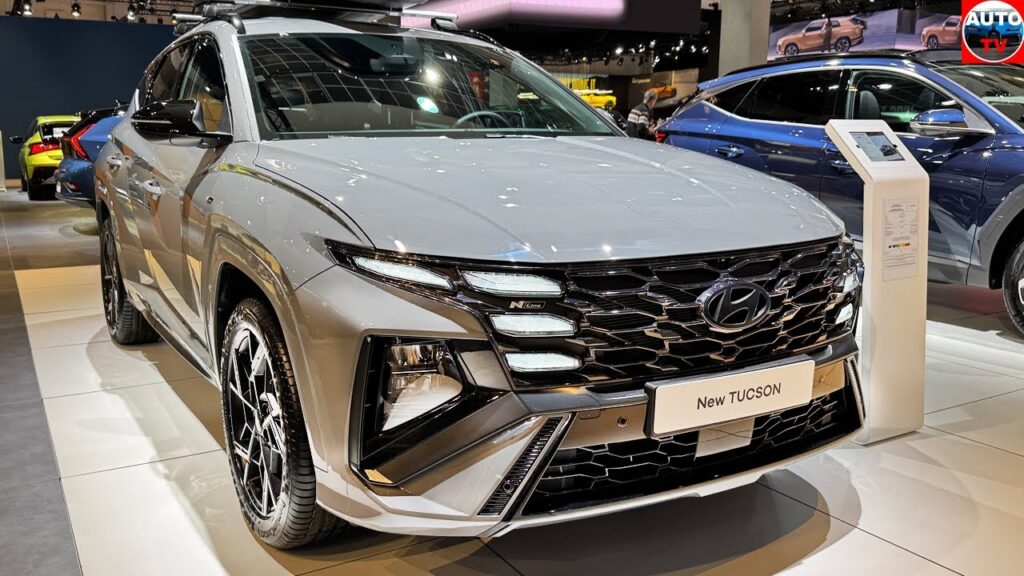In the ever-competitive compact SUV segment, the 2025 Hyundai Tucson has emerged as a formidable contender, challenging the dominance of stalwarts like the Toyota RAV4 and Honda CR-V. With its innovative design, advanced technology, and impressive performance, the Tucson is redefining what consumers can expect from a compact SUV.
Exterior Design
The 2025 Hyundai Tucson boasts a striking exterior that sets it apart from its competitors. Featuring a redesigned grille, updated bumpers, and sleek LED lighting, the Tucson presents a futuristic and aggressive stance. The integration of hidden daytime running lights and new alloy wheel designs further enhances its visual appeal .
In comparison, the Toyota RAV4 maintains a more traditional SUV look with its robust front fascia and angular lines. While the RAV4’s design is rugged and familiar, it lacks the avant-garde aesthetics of the Tucson.
The Honda CR-V, on the other hand, offers a more conservative design with smoother curves and a less pronounced front grille. While the CR-V’s design is elegant, it doesn’t command attention in the same way the Tucson does.
Interior Comfort and Technology
Step inside the 2025 Tucson, and you’re greeted with a cabin that exudes sophistication and modernity. The centerpiece is a 12.3-inch touchscreen infotainment system that seamlessly integrates with the digital instrument cluster. This panoramic display offers intuitive controls and supports wireless Apple CarPlay and Android Auto, ensuring connectivity on the go .
The Toyota RAV4’s interior, while functional, features a smaller 8.0-inch touchscreen that can feel dated compared to the Tucson’s expansive display. The Honda CR-V offers a 7.0-inch touchscreen in its base trim, with higher trims featuring an 8.0-inch display. While these systems are user-friendly, they don’t match the Tucson’s high-tech appeal.
In terms of seating, the Tucson offers available stain-resistant cloth upholstery, providing both comfort and practicality. The RAV4 offers SofTex®-trimmed seats in higher trims, while the CR-V provides fabric upholstery with leather-trimmed options in its upper trims.
Performance and Efficiency
Under the hood, the 2025 Hyundai Tucson offers a range of powertrains to suit diverse driving preferences. The standard 2.5-liter four-cylinder engine delivers 187 horsepower, providing a balanced mix of power and efficiency. For those seeking more performance, the Tucson Hybrid boasts 231 horsepower, while the Plug-in Hybrid variant offers an impressive 261 horsepower .
The Toyota RAV4 comes equipped with a 2.5-liter four-cylinder engine producing 203 horsepower. While powerful, it doesn’t match the Tucson Hybrid’s performance. The Honda CR-V offers a 1.5-liter turbocharged engine with 190 horsepower, delivering a smooth ride but lacking the punch of the Tucson’s higher-output variants.
Fuel efficiency is another area where the Tucson excels. The Hybrid model achieves an estimated 35 MPG combined, while the Plug-in Hybrid offers an electric-only range of up to 42 miles, reducing the need for gasoline on short trips .
Safety Features
Hyundai has equipped the 2025 Tucson with a suite of advanced safety features, including Forward Attention Warning, Smart Cruise Control, and Blind-Spot Collision-Avoidance Assist. These systems work in harmony to provide a secure driving experience .
The Toyota RAV4 offers Toyota Safety Sense 2.0, which includes features like Pre-Collision System and Lane Departure Alert. While comprehensive, it doesn’t offer the same level of advanced technology as the Tucson.
The Honda CR-V comes standard with Honda Sensing, featuring Adaptive Cruise Control and Collision Mitigation Braking System. While effective, the system’s capabilities are more basic compared to the Tucson’s offerings.
Cargo Space and Practicality
The 2025 Hyundai Tucson provides ample cargo space, with up to 74.5 cubic feet available when the rear seats are folded down . This spacious interior makes it ideal for families and those needing extra storage capacity.
The Toyota RAV4 offers 69.8 cubic feet of cargo space, while the Honda CR-V provides 75.8 cubic feet. While the CR-V offers slightly more cargo space, the Tucson’s innovative interior design and features make it a more practical choice for many consumers.
Pricing and Value
The 2025 Hyundai Tucson starts at $28,355, offering a compelling value proposition with its extensive list of standard features and advanced technology .
The Toyota RAV4 begins at $27,575, and the Honda CR-V starts at $28,045. While competitively priced, these models don’t offer the same level of standard features and technology as the Tucson.
Conclusion
The 2025 Hyundai Tucson stands out in the compact SUV segment with its bold design, advanced technology, and impressive performance. While the Toyota RAV4 and Honda CR-V are strong competitors, the Tucson’s innovative features and value make it a compelling choice for consumers seeking a modern and capable compact SUV.
